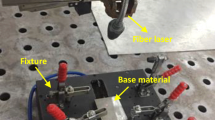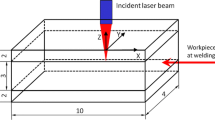Abstract
Quantitative prediction of the porosity defects in deep penetration laser welding has generally been considered as a very challenging task. In this study, a quantitative model of porosity defects induced by keyhole instability in partial penetration CO2 laser welding of a titanium alloy is proposed. The three-dimensional keyhole instability, weld pool dynamics, and pore formation are determined by direct numerical simulation, and the results are compared to prior experimental results. It is shown that the simulated keyhole depth fluctuations could represent the variation trends in the number and average size of pores for the studied process conditions. Moreover, it is found that it is possible to use the predicted keyhole depth fluctuations as a quantitative measure of the average size of porosity. The results also suggest that due to the shadowing effect of keyhole wall humps, the rapid cooling of the surface of the keyhole tip before keyhole collapse could lead to a substantial decrease in vapor pressure inside the keyhole tip, which is suggested to be the mechanism by which shielding gas enters into the porosity.










Similar content being viewed by others
References
S. Katayama, N. Seto, J.-D. Kim, and A. Matsunawa: ICALEO’97: Laser Materials Processing, vol. 83, pp. 17–20, California, 1997.
A.F.H. Kaplan, M. Mizutani, S. Katayama, and A Matsunawa: J. Phys. D, 2002, vol. 35, pp. 1218–28.
T.Y. Kuo and S.L. Jeng: J. Phys. D, 2005, vol. 38, pp. 722–28.
H. Zhao and T. DebRoy: Weld. J., 2001, vol. 80, pp. 204–10.
F. Abt, M. Boley, R. Weber, T. Graf, G. Popko, and S. Nau: Phys. Procedia, 2011, vol. 12, pp. 761–70.
Y. Arata, N. Abe, and T. Oda: Proc. ICALEO, 1983, vol. 83, pp. 59–66.
S. Fujinaga, H. Takenaka, T. Narikiyo, S. Katayama and A. Matsunawa: J. Phys. D, 2000, vol. 33, pp. 492–97.
N. Seto, S. Katayama, and A. Matsunawa: J. Laser. Appl., 2000, vol. 12, pp. 245–50.
J. Y. Lee, S. H. Ko, D. F. Farson, and C. D. Yoo: J. Phys. D, 2002, vol. 35, pp. 1570–76.
J. Zhou, H.L. Tsai, and Pei-Chung Wang: J. Heat. Trans., 2006, vol. 128, pp. 680–90.
J. Zhou and H.L. Tsai: J. Heat. Trans., 2007, vol. 129, pp. 1014–24.
J. Zhou and H.L. Tsai: Int. J. Heat. Mass. Trans., 2007, vol. 50, pp. 2217–35.
J. Zhou and H.L. Tsai: Int. J. Heat. Mass. Trans., 2008, vol. 51, pp. 4353–66.
J. Zhou, H.L. Tsai, and T.F. Lehnhoff: J. Phys. D, 2006, vol. 39, pp. 5338–55.
H. Ki, J. Mazumder, and P. S. Mohanty: Metall. Mater. Trans. A, 2002, vol. 33A, pp. 1817–30.
H. Ki, J. Mazumder, and P. S. Mohanty: Metall. Mater. Trans. A, 2002, vol. 33A, pp. 1831–42.
J.H. Cho and S.J. Na: Weld. J., 2009, vol. 88, pp. 35–43.
S. Pang, L. Chen, J. Zhou, Y. Yin, and T. Chen: J. Phys. D, 2011, vol. 44, p. 025301.
S. Pang, L. Chen, T. Chen, Y. Yin, L. Hu, and J. Liu: Laser. Technol., 2010, vol. 34, pp. 614–18.
S. Osher and R. Fedkiw: Level set Methods and Dynamic Implicit Surfaces, vol. 153, Springer-Verlag, New York, 2003.
V. Semak and A. Matsunawa: J. Phys. D, 1997, vol. 30, pp. 2541–52.
S.I. Anisimov: Sov. Phys. JETP, 1968, vol. 27, pp. 182–83.
H.B. Du: PhD Thesis, Huazhong University of Science and Technology, 2004.
A. Kaplan: J. Phys. D, 1994, vol. 27, pp. 1805–14.
H. Zhao, W. Niu, B. Zhang, Y. Lei, M. Kodama, and T. Ishide: J. Phys. D, 2011, vol. 44, pp. 485302–314.
H. Zhao and T. DebRoy: J. Appl. Phys., 2003, vol. 93, pp. 10089–096.
J. Hoffman and Z. Szymanski: J. Phys. D, 2004, vol. 37, pp. 1792–99.
T. Moscicki, J. Hoffman, and Z. Szymanski: J. Phys. D, 2006, vo1. 39, pp. 685–92.
C.M. Wang, X.X. Meng, W Huang, X.Y. Hu, and A.Q. Duan: J. Mater. Proc. Tech., 2011, vol. 211, pp. 668–74.
Acknowledgments
This research is financially supported by the National Natural Science Foundation of China (No. 51105153), the Specialized Research Fund for the Doctoral Program of Higher Education (No. 20100142110079), the Fundamental Research Fund for Central Universities (No. 2011QN082), and the Talent Recruitment Foundation of Huazhong University of Science and Technology (No. 0124110034).
Author information
Authors and Affiliations
Corresponding author
Additional information
Manuscript submitted May 6, 2013.
Rights and permissions
About this article
Cite this article
Pang, S., Chen, W. & Wang, W. A Quantitative Model of Keyhole Instability Induced Porosity in Laser Welding of Titanium Alloy. Metall Mater Trans A 45, 2808–2818 (2014). https://doi.org/10.1007/s11661-014-2231-3
Published:
Issue Date:
DOI: https://doi.org/10.1007/s11661-014-2231-3




